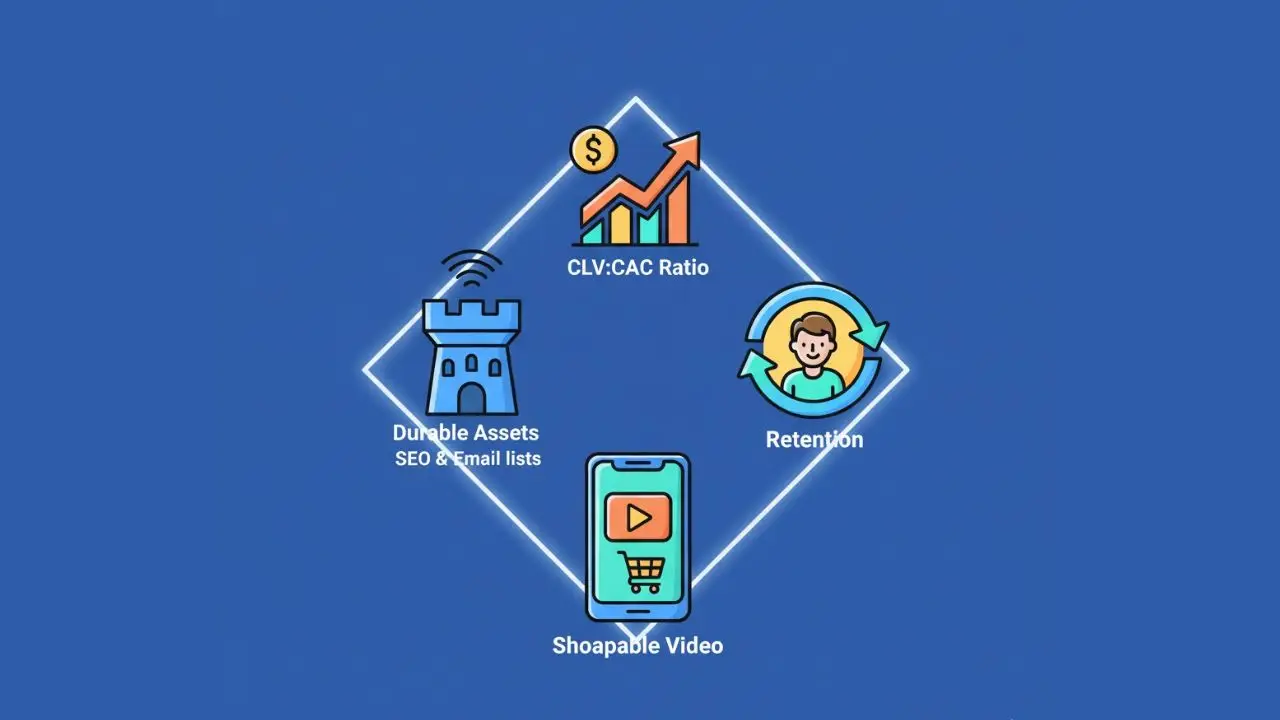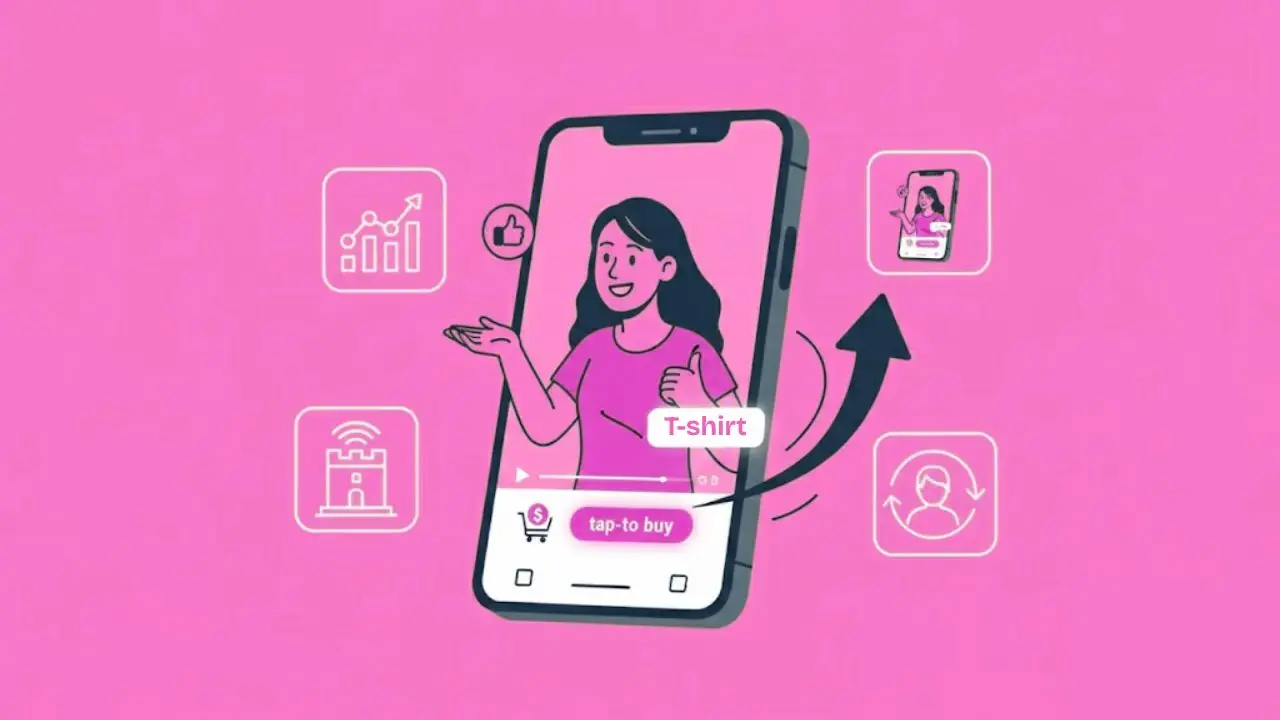Key Highlights
This guide moves beyond basic website optimization to cover the four strategic pillars that drive scalable e-commerce growth:
Reframing for Profit: Shifting focus from simple traffic to mastering the CLV:CAC ratio (Customer Lifetime Value vs. Customer Acquisition Cost).
Building Durable Assets: Treating SEO and email lists as long-term, appreciating assets, not just marketing expenses.
Engineering Retention: Systematically increasing profit by building a deliberate post-purchase experience to maximize repeat sales.
Adopting Next-Gen Tech: Using shoppable video to eliminate friction, merge inspiration with purchase, and gain a key competitive advantage.
If you’re running a serious e-commerce business, your team is likely already focused on the basics. You know that a fast-loading, mobile-friendly website with a simple checkout process is non-negotiable.
But these are not strategies. In 2025, they are the cost of entry.
True, sustainable growth doesn’t come from just optimizing your existing assets. It comes from building a scalable, multi-pillar ecosystem. While your competitors are busy A/B testing button colors, you can build a formidable growth engine. This guide moves beyond basic CRO to focus on the high-level strategies that drive scalable, profitable online business growth.
Pillar 1: Reframe E-commerce as a Financial Ecosystem
The first strategic shift for any business leader is to stop viewing e-commerce as a website and start treating it as a financial ecosystem governed by one core metric: The CLV:CAC Ratio.
Customer Lifetime Value (CLV): The total profit you expect from a single customer.
Customer Acquisition Cost (CAC): How much you spend to acquire that customer.
A healthy e-business must have a CLV that is a multiple of its CAC (a 3:1 ratio is a common benchmark). When you focus on this, every decision becomes clearer. Instead of asking “Will this get us more traffic?” you ask, “Will this attract profitable customers who stay?”
This is the macro-view your competitors are missing.
Pillar 2: Build Durable Assets, Not Just Campaigns
A paid ad campaign stops the moment your budget runs out. A business professional builds assets that grow in value over time.
Your E-commerce SEO as an Asset: High-value content and strong technical SEO are not just marketing expenses; they are appreciating assets. For instance, a top-ranking blog post can drive qualified, “free” traffic to your online store for years, continuously lowering your blended CAC.
Your Email List as an Asset: This is your most valuable owned-media channel. A strong email automation and segmentation strategy allows you to market to your most qualified prospects for near-zero cost, building the CLV side of your ratio.

Pillar 3: Engineer a Post-Purchase Retention Engine
Most e-commerce brands focus 90% of their effort on the first sale. This is the least profitable part of the business. The real profit is in the second, third, and fourth sale.
A strategic leader builds a deliberate post-purchase experience. This is not just a “Thank You” page.
Consequently, this system should include:
A sophisticated, automated welcome and education series.
Personalized cross-sell and up-sell recommendations based on past behavior.
A loyalty or rewards program that actually provides value and encourages repeat purchases.
A proactive customer service experience that solves problems before they become complaints.
This is how you systematically increase your Customer Lifetime Value.
Pillar 4: The Next Frontier: From Static Visuals to Interactive Commerce
Your competitor’s blog correctly identified that high-quality images and videos are important. But that’s where their thinking stopped. The next generation of digital commerce is about closing the gap between engagement and purchase.
The Shoppable Video Revolution
Static images are passive. Customers look, then they must search for the product, add it to the cart, and check out. This creates friction at every step.
Shoppable video, or interactive video, is the solution.
This technology allows a customer to purchase a product directly from within the video at the exact moment their interest is highest.
Why this is a strategic growth lever, not a gimmick:
It Annihilates Friction: It shrinks the customer journey from 5-6 steps down to one. They see it, they like it, they buy it.
It Skyrockets Conversion: By merging the “inspiration” phase (watching the video) with the “action” phase (purchasing), you capture the impulse.
It Boosts Engagement & AOV: Customers are more engaged and, because videos can showcase multiple products in a “look” or “bundle,” they often lead to a higher Average Order Value (AOV).
While your competition is still just uploading product photos, you can implement an interactive experience that converts viewers into customers instantly.
Conclusion: Build Your E-commerce Growth System
Don’t just optimize your e-commerce store; build a growth ecosystem.
The foundation of speed, trust, and mobile-friendliness is where you start, not where you finish. True, scalable growth for your online business comes from a strategic, data-driven approach:
Mastering your CLV:CAC ratio.
Building durable assets like SEO.
Engineering a retention engine to maximize profit.
Adopting next-generation technology like shoppable video to create an unbeatable competitive advantage.

